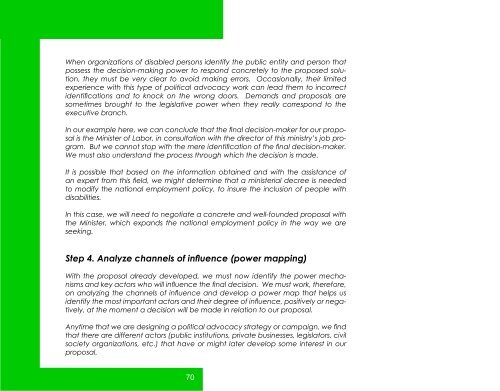in English - Handicap International
in English - Handicap International
in English - Handicap International
Create successful ePaper yourself
Turn your PDF publications into a flip-book with our unique Google optimized e-Paper software.
When organizations of disabled persons identify the public entity and person that<br />
possess the decision-mak<strong>in</strong>g power to respond concretely to the proposed solution,<br />
they must be very clear to avoid mak<strong>in</strong>g errors. Occasionally, their limited<br />
experience with this type of political advocacy work can lead them to <strong>in</strong>correct<br />
identifications and to knock on the wrong doors. Demands and proposals are<br />
sometimes brought to the legislative power when they really correspond to the<br />
executive branch.<br />
In our example here, we can conclude that the f<strong>in</strong>al decision-maker for our proposal<br />
is the M<strong>in</strong>ister of Labor, <strong>in</strong> consultation with the director of this m<strong>in</strong>istry’s job program.<br />
But we cannot stop with the mere identification of the f<strong>in</strong>al decision-maker.<br />
We must also understand the process through which the decision is made.<br />
It is possible that based on the <strong>in</strong>formation obta<strong>in</strong>ed and with the assistance of<br />
an expert from this field, we might determ<strong>in</strong>e that a m<strong>in</strong>isterial decree is needed<br />
to modify the national employment policy, to <strong>in</strong>sure the <strong>in</strong>clusion of people with<br />
disabilities.<br />
In this case, we will need to negotiate a concrete and well-founded proposal with<br />
the M<strong>in</strong>ister, which expands the national employment policy <strong>in</strong> the way we are<br />
seek<strong>in</strong>g.<br />
Step 4. Analyze channels of <strong>in</strong>fluence (power mapp<strong>in</strong>g)<br />
With the proposal already developed, we must now identify the power mechanisms<br />
and key actors who will <strong>in</strong>fluence the f<strong>in</strong>al decision. We must work, therefore,<br />
on analyz<strong>in</strong>g the channels of <strong>in</strong>fluence and develop a power map that helps us<br />
identify the most important actors and their degree of <strong>in</strong>fluence, positively or negatively,<br />
at the moment a decision will be made <strong>in</strong> relation to our proposal.<br />
Anytime that we are design<strong>in</strong>g a political advocacy strategy or campaign, we f<strong>in</strong>d<br />
that there are different actors (public <strong>in</strong>stitutions, private bus<strong>in</strong>esses, legislators, civil<br />
society organizations, etc.) that have or might later develop some <strong>in</strong>terest <strong>in</strong> our<br />
proposal.<br />
70

















